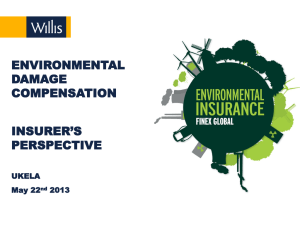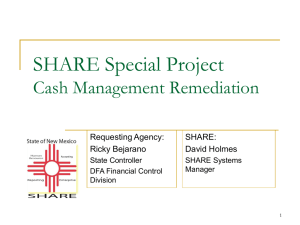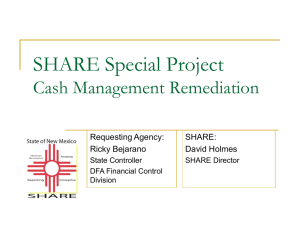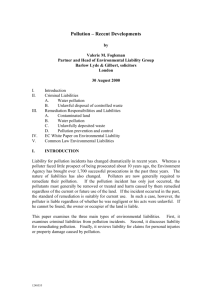Pollution Remediation Guidance
advertisement
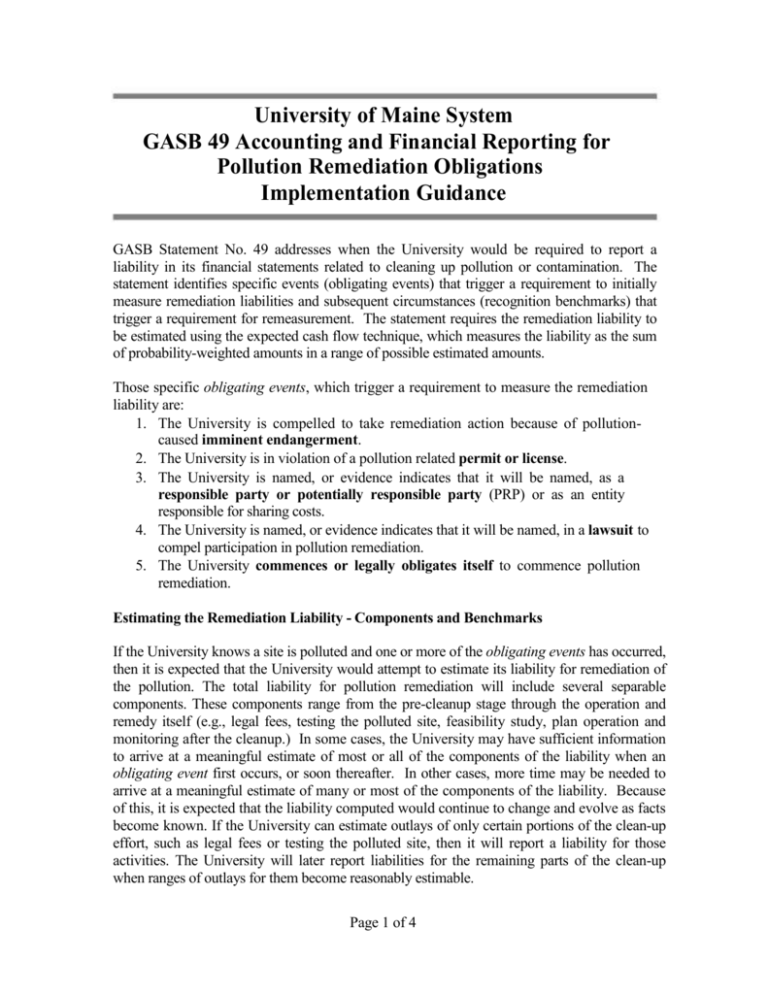
University of Maine System GASB 49 Accounting and Financial Reporting for Pollution Remediation Obligations Implementation Guidance GASB Statement No. 49 addresses when the University would be required to report a liability in its financial statements related to cleaning up pollution or contamination. The statement identifies specific events (obligating events) that trigger a requirement to initially measure remediation liabilities and subsequent circumstances (recognition benchmarks) that trigger a requirement for remeasurement. The statement requires the remediation liability to be estimated using the expected cash flow technique, which measures the liability as the sum of probability-weighted amounts in a range of possible estimated amounts. Those specific obligating events, which trigger a requirement to measure the remediation liability are: 1. The University is compelled to take remediation action because of pollutioncaused imminent endangerment. 2. The University is in violation of a pollution related permit or license. 3. The University is named, or evidence indicates that it will be named, as a responsible party or potentially responsible party (PRP) or as an entity responsible for sharing costs. 4. The University is named, or evidence indicates that it will be named, in a lawsuit to compel participation in pollution remediation. 5. The University commences or legally obligates itself to commence pollution remediation. Estimating the Remediation Liability - Components and Benchmarks If the University knows a site is polluted and one or more of the obligating events has occurred, then it is expected that the University would attempt to estimate its liability for remediation of the pollution. The total liability for pollution remediation will include several separable components. These components range from the pre-cleanup stage through the operation and remedy itself (e.g., legal fees, testing the polluted site, feasibility study, plan operation and monitoring after the cleanup.) In some cases, the University may have sufficient information to arrive at a meaningful estimate of most or all of the components of the liability when an obligating event first occurs, or soon thereafter. In other cases, more time may be needed to arrive at a meaningful estimate of many or most of the components of the liability. Because of this, it is expected that the liability computed would continue to change and evolve as facts become known. If the University can estimate outlays of only certain portions of the clean-up effort, such as legal fees or testing the polluted site, then it will report a liability for those activities. The University will later report liabilities for the remaining parts of the clean-up when ranges of outlays for them become reasonably estimable. Page 1 of 4 The statement identifies benchmarks, or milestones, that are considered turning points for evaluation when a component of a liability becomes reasonably estimable. These benchmarks are a summons to reconsider the possibility of recognizing what ideally should have already been recognized. Thus, a benchmark should always trigger, rather than delay, recognition. Benchmarks include receipt of an administrative order; participation in a site assessment or investigation; completion of a corrective action feasibility study; issuance of an authorization to proceed; and design and implementation of the remedy through post-remediation monitoring. Measuring the Amount of the Liability GASB No. 49 sets forth a method for estimating liabilities using an expected cash flows measurement technique. Expected cash flows are based on estimated ranges of outlays for pollution cleanup. This approach involves assigning probabilities or likelihoods to each of the potential outlays and calculating a weighted average of them. For example, a University estimates that outlays to conduct a site assessment and complete a corrective measures feasibility study will range from $80,000 to $120,000. Either end of the range is equally likely, although actual outlays are considered 40 percent likely to be close to $95,000. The expected cash flow would be calculated as follows: ($80,000 × 30%) + ($95,000 × 40%) + ($120,000 x 30%) = $98,000 Flowchart Depiction The flowchart on the following page is presented to aid in the application of this statement: Page 2 of 4 University knows or reasonably believes site is polluted/ contaminated Imminent endangerment compels University to take remediation action University violates pollution prevention-related permit/license Is the range of one or more components of the pollution remediation obligation reasonably estimable? University is named, or evidence indicates University will be named, as a Responsible Party or Potentially Responsible Party Yes University is named, or evidence indicates University will be named, in a lawsuit to enforce cleanup University Commences or legally obligates itself to commence cleanup, monitoring, or maintenance and operation activities Estimate current value of outlays using the expected cash flow technique. Remeasure when new information indicates a change in estimated outlays Record pollution remediation liability for these expected outlays. Recognize additional components, if any, of the pollution remediation liability as their ranges become reasonably estimable, following recognition benchmarks. For recognized pollution remediation liabilities disclose the nature and source of pollution remediation obligation, the amount of estimated liability, the methods and assumption used for the estimate, potential changes in the liability, and an estimate of the amount the University expects to recover from insurance or other parties. Disclose a general description of the nature of pollution remediation activities for portions of liabilities that are not yet recognized because they are not reasonably estimable. Discuss a general description of the nature of pollution remediation activities Page 3 of 4 Note Disclosure If the liability or portions of it are not reported in the financial statements because a range of potential outlays cannot be estimated, then the University should describe the nature of the pollution remediation activities in the notes to the financial statements. For liabilities that are recognized the University should disclose the following information: • The nature and source of pollution remediation obligations (for example, federal, state, or local laws or regulations) • The amount of the estimated liability (if not apparent from the financial statements) • The methods and assumptions used for the estimate • The potential for changes due to, for example, price increases or reductions, technology, or applicable laws or regulations, and other factors. • An estimate of the amount the University expects to recover from insurance or other parties, thereby reducing the liability. Additional Information The Excel file that accompanies this memo includes a pollution remediation questionnaire, guidance on measuring the liability, and required note disclosure information. Please provide completed forms electronically to janis.manning@maine.edu or by mail to Janis Manning, Assistant Director of Accounting, at University of Maine System, 16 Central Street, Bangor, ME 04401. Please send all responses by July 31. For more information or assistance, please contact Janis Manning at 973-3315. Thank you for your assistance. Page 4 of 4
